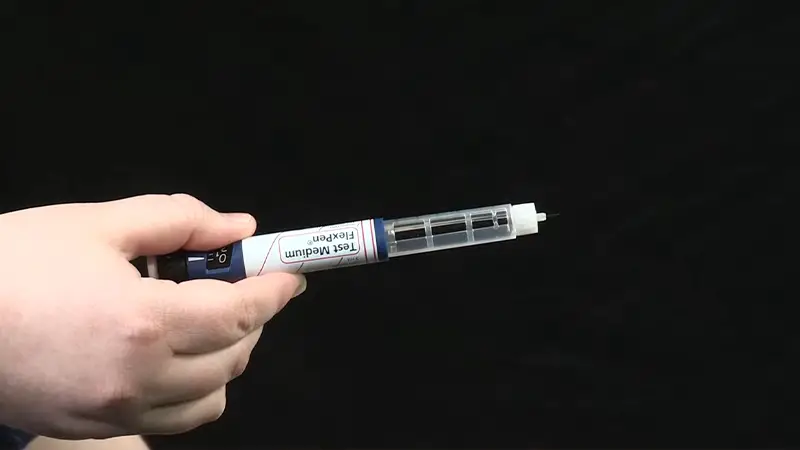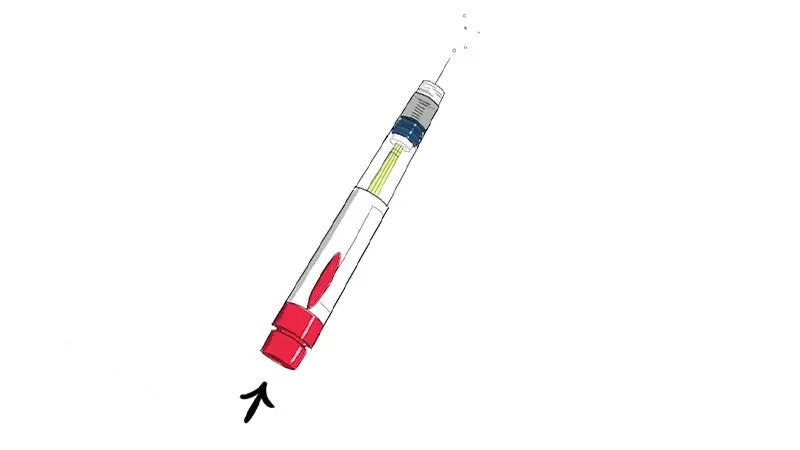Managing diabetes often involves the use of insulin pens, which are designed for easy and convenient self-administration of insulin.
However, getting air bubbles out of an insulin pen is a critical skill that every diabetic should master to ensure accurate dosing and effective glucose control.
Air bubbles can compromise the precision of insulin delivery, potentially leading to underdosing and erratic blood sugar levels. Understanding the methods to eliminate these bubbles is vital for maintaining optimal health.
This discussion explores the various techniques and tips to effectively remove air bubbles from an insulin pen.
We will cover how do you get air bubbles out of an insulin pen to confidently manage their condition and ensure the reliability of their insulin administration.
How Do You Get Air Bubbles Out Of An Insulin Pen?
Getting air bubbles out of an insulin pen is essential to ensure accurate dosing and prevent injecting air into your body. Here are some simple methods to remove air bubbles:
Prime the Pen
Before each injection, prime the pen by dialing up a small amount of insulin and expelling it into the air until no air bubbles are visible in the insulin stream. This helps eliminate air from the cartridge and needle.
Tap the Pen
Gently tap the pen with your finger to dislodge any trapped air bubbles. Hold the pen with the needle pointing upwards while tapping.
Slowly Push the Plunger
Instead of quickly pressing the plunger, do it slowly to allow air bubbles to rise to the top of the cartridge. Push the plunger until a tiny droplet appears at the needle tip.
Rotate the Pen
Before injecting, gently rotate the pen with the needle pointing upward to encourage air bubbles to move to the top of the cartridge. Tap the pen again if needed.
Draw insulin Carefully
Draw insulin with a steady, smooth motion to prevent air from being pulled into the cartridge. Avoid jerky or fast movements.
Change the Needle
If you still notice air bubbles, change the needle. Sometimes, the needle can trap air, and a fresh needle may help avoid this issue.
Use a New Cartridge
If you consistently experience air bubble problems, consider using a new cartridge. Old or damaged cartridges can contribute to air bubble formation.
Keep the pen Upright
Store your insulin pen upright when not in use. This minimizes the chances of air bubbles accumulating at the top of the cartridge.
Consult Your Healthcare Provider
If air bubbles persist or if you’re unsure about managing them, consult your healthcare provider or diabetes educator for guidance on your specific insulin pen and dosing technique.
Properly managing air bubbles in your insulin pen ensures that you receive the correct insulin dose and helps maintain effective diabetes management. Always follow your healthcare provider’s recommendations and insulin pen instructions for safe and accurate dosing.
What Happens If You Inject Air When Injecting Insulin?

Injecting air along with insulin can have several consequences, although the effects are typically not as severe as they are often portrayed in movies or television.
Here are some potential consequences:
Inaccurate Dosing
The most immediate consequence is inaccurate dosing. Air bubbles can displace a portion of the insulin, resulting in a lower dose than intended. This may lead to higher blood sugar levels, particularly if the under-dosing is consistent.
Hyperglycemia
Injecting air can contribute to elevated blood sugar levels (hyperglycemia). In cases of significant air injection, the potential for high blood glucose is greater, which may necessitate additional insulin to correct the situation.
Temporary Discomfort
Some individuals might experience temporary discomfort at the injection site due to the presence of air. It can cause mild pain, itching, or a slight burning sensation, but this typically subsides quickly.
No Long-Term Health Risks
Injecting a small amount of air is generally not associated with long-term health risks. The body can typically absorb small air bubbles without causing harm.
Psychological Stress
For some individuals, the act of injecting air can lead to psychological stress or anxiety, as they may be concerned about the potential consequences of air injection.
Compromised Insulin Effectiveness
In cases of significant air injection, the effectiveness of the injected insulin may be compromised, resulting in prolonged hyperglycemia and the need for additional insulin to correct it.
Reduced Insulin Absorption
Air bubbles can obstruct the flow of insulin into the subcutaneous tissue. While this typically occurs with larger volumes of air, it can delay insulin absorption and affect blood sugar control.
Lipohypertrophy Risk
Frequent injection of air or improper injection technique can lead to the development of lipohypertrophy, a condition characterized by lumps or fatty deposits at the injection site.
These areas can absorb insulin differently, leading to erratic blood glucose levels.
Rare Severe Complications
In extremely rare cases, the injection of a large volume of air, such as from a malfunctioning device, could theoretically lead to more severe complications, like an air embolism. However, this is highly unlikely with typical insulin injections and equipment.
It’s important to avoid injecting air intentionally, but small air bubbles that may be inadvertently injected while using insulin pens are usually not a cause for significant concern.
However, it’s always a good practice to remove any air bubbles before injecting insulin to ensure accurate dosing and effective blood sugar control.
If you have concerns about air injection or experience any unusual symptoms, consult with your healthcare provider.
Why Is It Important To Remove Air Bubbles From A Syringe?

Removing air bubbles from a syringe is essential for several reasons, as air in the syringe can have various adverse consequences. Here are some important reasons to ensure air bubbles are eliminated:
Accurate Dosage
The presence of air bubbles can displace the medication in the syringe, leading to an inaccurate dosage. Ensuring air-free injections helps guarantee the precise amount of medication is administered.
Treatment Efficacy
Accurate dosing is crucial for the effectiveness of the medication. By removing air bubbles, you enhance the likelihood that the treatment will have the desired effect on your condition.
Patient Safety
Injecting air bubbles can pose a risk to patient safety. While small amounts of air are generally not harmful, large volumes of air can lead to complications such as air embolisms, which are rare but potentially serious.
Preventing Waste
Removing air bubbles helps prevent the wastage of medication. Medications can be expensive, and any loss due to inaccurate dosing can be costly over time.
Consistent Blood Levels
For medications that affect blood levels, such as insulin, accurate dosing is crucial to maintaining consistent blood levels. Injecting air can lead to fluctuations in blood sugar or other biomarkers.
Avoiding Side Effects
Incorrect dosing due to air bubbles can lead to unwanted side effects or diminished therapeutic benefits. Removing air bubbles minimizes the risk of such adverse reactions.
Preventing Injection Site Irritation
The presence of air bubbles can cause discomfort or irritation at the injection site. Ensuring air-free injections enhances patient comfort.
Patient Confidence
Accurate dosing instills confidence in patients that their treatment is being administered correctly. It promotes adherence to treatment regimens and fosters trust in healthcare providers.
Preventing Infection Risk
Inadequate priming or injecting air can contaminate the medication and increase the risk of infections. Proper injection practices, including removing air bubbles, help maintain a sterile environment.
Overall, removing air bubbles from a syringe is a fundamental step in the administration of medications to ensure patient safety, accurate dosing, treatment efficacy, and adherence to best practices in healthcare.
It’s a simple yet crucial aspect of responsible medication administration.
FAQs
How do air bubbles form in insulin pens, and why are they a concern?
Air bubbles can enter insulin pens during the process of priming or replacing the cap. They are a concern because, if injected, they can disrupt the accurate insulin dosage, potentially leading to irregular blood sugar levels and inadequate diabetes management.
What’s the recommended method to remove air bubbles from an insulin pen?
To remove air bubbles, hold the pen upright, tap the cartridge to dislodge bubbles, then perform a small air shot by dialing up a small dose and expelling it until a droplet appears. Ensure the droplet contains only insulin, indicating that air bubbles are eliminated.
Is it normal to see tiny air bubbles in the insulin cartridge?
Tiny air bubbles might be visible, but they usually do not affect the dosage significantly. However, it’s best to minimize them to maintain accurate insulin delivery.
Follow the priming and tapping techniques to remove larger bubbles for precise dosing.
Can air bubbles be completely eliminated from the insulin pen?
While it’s challenging to eliminate every single air bubble, you can minimize them significantly by priming the pen carefully, tapping the cartridge, and expelling small doses. The goal is to remove enough bubbles to ensure accurate insulin doses.
What should I do if I accidentally inject insulin with air bubbles?
If you suspect injecting air bubbles, consult your healthcare provider. They can assess your situation and guide you accordingly. It’s crucial to be cautious, as injecting large volumes of air may pose risks, although small bubbles are generally absorbed harmlessly by the body.
Conclusion
The importance of knowing how to get air bubbles out of an insulin pen cannot be overstated for individuals living with diabetes. Proper insulin dosing is crucial for maintaining stable blood sugar levels and overall health.
The methods discussed, such as priming, tapping, and rotating the pen, offer practical solutions to prevent air bubble-related complications and ensure accurate insulin delivery.
By mastering these techniques, individuals can enhance their confidence in managing their condition and enjoy greater control over their diabetes management.
The ability to effectively remove air bubbles from an insulin pen is an essential skill that empowers individuals to maintain their well-being and achieve more consistent glucose control in their daily lives.
Hi, I’m Mark Pattinson and I’m a freelance personal trainer. I’ve been working in the fitness industry for over 10 years especially since I work with diabetes patients and I love helping people achieve their fitness goals. I believe that everyone can benefit from a good workout, and I’ll do everything to make sure you get the most out of your training.